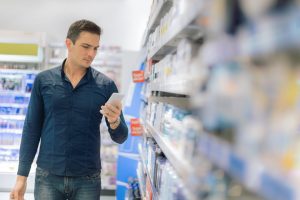6 essential KPIs for retail marketing in the digital age
Key performance indicators (KPIs) are the foundation of any successful retail marketing strategy. After setting specific, measurable, achievable, realistic, and timely goals and putting the right measurement tools in place, the marketing team charts progress based on goal forecasting and benchmark achievement over time. When thinking about which KPIs matter for you and your company, annual revenue and conversions may be the first two metrics that come to mind. However, the key KPIs for retail marketing include a mix of online and offline metrics. When analyzed together, marketers can gain an in-depth understanding of how well their omnichannel strategies are working. The data can also be used to finetune and personalize future campaigns. There is an endless amount of trackable data, but the most essential KPIs for retailers include: digital traffic, foot traffic, cart size, in-aisle engagement, overall brand awareness, and return on investment (ROI).
Digital Traffic
It’s vital to measure how many people are visiting your retail website. Traffic may fluctuate from month to month depending on the season, but should trend upward year-over-year, verifying the success and health of your site.
Knowing from which source users are visiting your site is equally important—whether from pay-per-click (PPC) ads, organic search, or social media referrals—so the company can double-down on successful strategies and discard or revamp the rest.
Consumers use multiple channels to shop, so it’s also wise to compare online vs. offline traffic to better understand how a digital presence impacts physical retail. The impact of eCommerce can be valued by breaking down traffic by zip code.
There are endless strategies for increasing web traffic, but the best produce long-term, sustainable growth. While PPC ads can give retailers a quick bump in sales and are often included in marketing mixes, far too many retailers place too much stock in this short-lived strategy. When a company stops investing in paid ads, the benefits are instantly lost. On the other hand, investing in content marketing and search engine optimization (SEO) will continue to produce growth and results over the years.
The following online tactics represent best practices for driving retail web traffic:
- Advertise referral bonuses on the website and social media channels.
- Produce more consistent, diverse, and optimized content.
- Optimize the website with well-researched and competitive long-tail keywords.
- Encourage links to the website through third-party publications, press releases, and networking.
- Ensure digital directory and review sites have accurate and adequate information.
- Optimize the website for mobile devices.
- Partner with third-party shopping apps like Shopkick to increase the company’s footprint within new audiences.
- Automate retargeting campaigns based on user behaviors like leaving items in shopping carts or browsing the site.
Physical KPIs for Retail Marketing
Though we’ve been living in “the Digital Age” since the 1970s, eCommerce will likely never replace the physical brick-and-mortar shopping experience. In fact, 90% of sales still occur in stores.
Consumers still like to physically handle products before purchasing, browse all available options, ask the advice of store personnel, and have items immediately available after purchasing. Over a third of shoppers enjoy “retail therapy” as a way of destressing, and they tend to spend more than online shoppers.
In the past, it was a bit more of a complex process to gain personalized data on physical retail shoppers. However, advancements in technology have brought about tools like smartphones, beacons, smart mirrors, smart carts, interactive screen displays, and augmented reality headsets that can be utilized to bridge gaps between data collection and physical shopping.
Foot Traffic
Foot traffic refers to the number of people who walk into the store. This metric can be measured using camera surveillance, heat maps, and retail analytics software. It’s worth measuring store traffic to gauge how many are browsing vs. buying.
Are you stocking what people need? Is a recently launched marketing campaign or a new product launch driving greater store visits? Are your window displays or geolocation-based text campaigns bringing local traffic in off the street?
There are many ways to drive foot traffic:
- Increase exterior curb appeal.
- Implement buy online pick up in store (BOPIS).
- Hold local events.
- Advertise on Google Local.
- Send location-based texts.
- Run flash sales during slow times.
- Show real-time inventory online.
- Partner with a shopping loyalty app like Shopkick that encourages and rewards shoppers for visiting a store.
Cart Size
Foot traffic refers to the number of people who walk into the store. This metric can be measured using camera surveillance, heat maps, and retail analytics software. It’s worth measuring store traffic to gauge how many are browsing vs. buying.
Are you stocking what people need? Is a recently launched marketing campaign or a new product launch driving greater store visits? Are your window displays or geolocation-based text campaigns bringing local traffic in off the street?
There are many ways to drive foot traffic:
- Increase exterior curb appeal.
- Implement buy online pick up in store (BOPIS).
- Hold local events.
- Advertise on Google Local.
- Send location-based texts.
- Run flash sales during slow times.
- Show real-time inventory online.
- Partner with a shopping loyalty app like Shopkick that encourages and rewards shoppers for visiting a store.
At-Shelf Product Engagement
Forward-thinking retailers explore how consumers engage with particular products in-aisle. 3D-eye-tracking technology can gauge visual attention, heat sensor mapping can reveal popular zones, and mobile tracking can identify how people engage with particular products or aisles.
Where do shoppers go first when they arrive in-store? Are they lingering down certain aisles? Which shelves or displays capture the most sustained attention? Which items do people scan with smartphones to get more information?
To increase product engagement at-shelf:
- Gamify the shopping experience.
- Activate mobile barcode scanning.
- Text offers using near-field communication (NFC) technology.
- Hold in-store product demos.
- Engage with a rewards app.
- Show location-based in-app videos.
- Use screens displays to provide info.
- Bundle offers to drive new product trial
Shopkick is an innovative platform used to foster brand loyalty, as it rewards consumers for engagement, not just purchases. It also works across channels, whether a shopper wants to browse or buy online or in-store.
When eBay partnered with Shopkick, they were able to increase their app install rate by 6%, boost their new audience participation rate 62%, and achieve an 18% repeat-purchase rate.
Best of all, Shopkick rewards with points instead of immediate discounts, so there is no need to worry about diluting profit margins or devaluing your brand.
Brand Awareness
Brand awareness may be particularly salient if you’re launching a new product or just starting out. However, understanding if and how consumers are aware of your brand is critical to understanding which marketing strategies are successful, and which need to be improved upon.
The starting point for measuring awareness can be found in Google Analytics data, which breaks down website traffic based on source. Consumer surveys are another way to track awareness of a retail brand.
Brand awareness can be measured in a myriad of ways—website/foot traffic, branded search prevalence, the number of backlinks, overall share of market voice, social media likes/comments/mentions, and even competitive comparisons.
To increase brand awareness, retailers can:
- Run native ads and social media ads.
- Produce fun and informative videos.
- Partner with influencers for reviews and links.
- Hold offline events and cross-promotions.
- Redesign company colors, logos, and brand images.
- Advertise in mobile shopping apps to expand reach.
One metric to always keep in mind when analyzing a marketing program’s effectiveness is the ROI. No one wants to spend more money to advertise than what is necessary to capitalize. Campaigns with the best ROI tend to leverage partnerships, personalization strategies, and make use of digital efforts like SEO, content, email, and mobile.
Tracking KPIs for retail marketing has gotten easier with customer relationship management software and the wide plethora of digital tools at marketers’ disposal, but it can be overwhelming for retailers to know where to begin. Many companies work with third-party marketers, SEO content firms, and consultants to assess their current conditions and gain campaign traction. Partnerships are yet another way to turbocharge a retail marketing strategy and earn a significant ROI.
Shopkick offers partners actionable first-party data that can help them track key metrics (foot traffic, at-shelf engagement, demographics/psychographics, etc.) in-store in real-time. This data allows our partners to fill gaps in the consumer shopping journey and make more insightful marketing decisions. The digital age is not slowing down; now is the time for retailers to adapt to the changing retail landscape and integrate technology into their marketing strategies.



